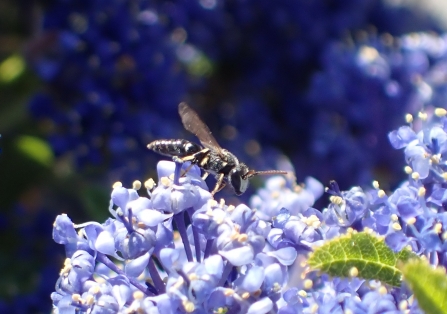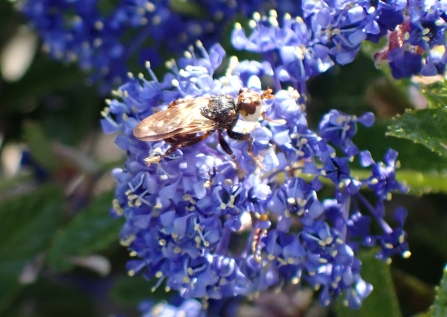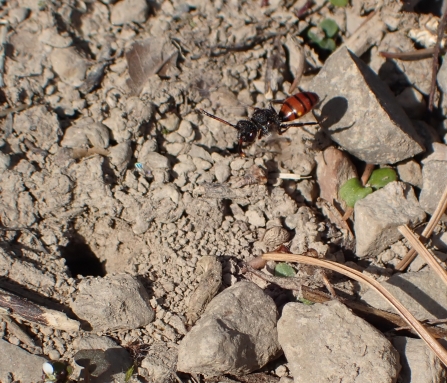With all the problems wildlife is facing at the moment due to habitat loss and our increasingly more unpredictable climate, I am sure those of us lucky enough to have a garden, have been thinking about how to make it more wildlife friendly. If you read my blog last month you will know that I am a big fan of doing nothing and letting nature do its thing. However l know that we all like to lend nature a helping hand and have probably thought about adding some additional features such as a small pond as this is a great way to encourage different animals into a garden. Once the pond is in place our thoughts probably turn towards adding some new plants; but which ones are best? Our native trees and shrubs should be a safe bet as they will be able to provide essential food and shelter for our native animals but is this always the right thing to do?
Are native plants best for wildlife gardening?
Ceanothus bush in author's garden © Tim Ward
Animals and plants have developed complex relationships
Clearly not all animals need the same plants and the best plants for some animals may not be the best for others. Therefore, in order to answer this question and choose which plants to add, you need to have an idea about what you want to attract into the garden. Many invertebrates have very specialized feeding requirements and may only be associated with a family or a specific species of plant; usually a native one. This is particularly true of Lepidoptera (butterflies and moths). If you have ever tried to grow cabbages without using a net to protect them from Large White butterflies, you will be very familiar with this creature's preferences. You may also have been lucky enough to find clusters of dark, spiny looking caterpillars on nettles. These are likely to be the larvae of Peacock or Small Tortoiseshell butterflies. There is also a group of tiny moths called leaf-miners that have larvae that live inside the leaves of plants. The larvae are often only found on one type of tree, shrub or herbaceous plant. The type of plant in combination with the shape of their burrows in the leaves (mines) and the patterns of their droppings (frass), is the best, and sometimes only, way to identify them. This is because the adult moths are only a few millimetres long and often look so similar that even when you can find them it may be almost impossible to separate the different species, so finding the leaf mine is a great method of identification.
A leaf mine of Eriocrania cicatricella in a Birch leaf © Tim Ward
Therefore it is true to say that having a good range of our native plants in your garden is a great foundation for a diverse range of invertebrates but if you want to support a specific species you need to make sure you include the specific plants that they require. What’s more, by having a diverse population of invertebrates you will also ensure you are supporting the invertebrate and vertebrate predators that depend on them for food.
Tawny mining bee (Andrena fulva) on early flowering shrub. One of the most distinctive of our solitary bees © Tim Ward
A plea for the bee!
The plight of our bees has been in the news a lot recently so l have been thinking about how we could modify our gardens specifically to support them. And when I say bees, I am not just referring to honey bees but also to our native bees and there are over 260 different species. About 25 species are bumble bees, give or take a few that may now be extinct in the UK, and the remainder are and solitary bees which are responsible for much plant pollination. A report prepared for the government in 2017 stated that in the UK, despite new controls on certain pesticides, there has been an overall decline in wild bee diversity over the last 50 years echoing a similar worldwide trend, and across Europe, over 9% of wild bee species are threatened with extinction. Also since starting to look at them in more detail I have become aware of what a fascinating and diverse group of creatures they are.

A tiny male Hairy Yellow-face bee (Hyleaus hyalinatus) on Ceanothus. It is only 5mm long but if you look closely, very distinctive, due to its hairy face and orangey antenna © Tim Ward
Interesting fact: Approximately 30% of UK bee species are Cuckoo bees (cleptoparasites that lay their eggs in the nests of other species). Despite this, these bees still frequently visit flowers for nectar and are also responsible for pollination of them.

Female Gooden’s Nomad Bee (Nomada goodeniana) nectaring on a creeping thyme. This species is a cleptoparasite of Andrena bees © Tim Ward
To support them we need to understand the things that they need. There are a few species that time their emergence in the spring to coincide with the flowering of particular plants such as sallow and several are specialists (monolectic) and only collect pollen and nectar from specific species of flowers. However most species will visit a wide range of different flowers (polylectic) provided the pollen and nectar is easily accessible. The more robust bumblebees seem to visit the widest range of flower types including the larger tube shaped flowers. They also tend to be more active on overcast days and at lower temperatures as well as on warm sunny days when most solitary bees become active.
The author’s garden in spring © Tim Ward
Which flowers do bees prefer?
I am very lucky in that I have a relatively large garden that contains a large number of different types of trees, shrubs and herbaceous plants including both native and ornamental varieties. This plant diversity creates a flowering season that stretches throughout the year and a great opportunity for exploring bee preferences. Although I have not done any detailed data collection and analysis, as I walked around the garden this spring it was immediately obvious that many of the ornamental plants were very attractive to bees of all types from tiny mining bees a few millimetres long to large queen bumblebees. When compared to the density of bees visiting plants in the hedgerows around the edges of our garden, it was clear that many more were visiting the ornamental plants in the garden. This was especially true for most of the solitary bees, where I observed only relatively small numbers outside the garden. When you think about it, this is probably not too surprising as many ornamental plants have been selected for their high flower density which often means they have lots of pollen and nectar too.
Bees and flies (https://youtu.be/Npoxygu5xLU)
Bees and flies nectaring on a Ceanothus bush in spring © Tim Ward
This has been well illustrated over the last few weeks by a wonderful Ceanothus (Californian Lilac) bush which has been covered in tiny, blue, sweet scented flowers, which in turn have been smothered by bees (and hoverflies). When I compared this to a hawthorn tree with a similar aspect, it had less than 10% of the number of bees. Similarly, a small patch of creeping thyme by our house covering about half a square metre in a sunny spot; constantly has over 30 bees from at least 5 different genera feasting amongst the flowers. Interestingly these same flowers are often visited by some of the flies that parasitize bees.

Ferruginous Bee-grabber – a conopid fly that is a parasite of bumblebees © Tim Ward
The common factor amongst these bee 'super plants' is that they seem to have small flowers at high density with very accessible pollen, plus, based on the sweet smell, I assume lots of nectar.
Ornamental plants can be beneficial in the garden
Having a good range of native plants and creating a flower filled lawn by leaving it unmown in the spring and summer will create a lot of extra flowers that are excellent for bees. However my conclusion is that although native plants are essential for a healthy wildlife garden, if you want a lot of bees it may be good to include a few ornamental plants amongst the native ones. In other words it is the bee equivalent of providing sunflower hearts and peanuts for birds. And in supporting bees you will also be supporting many other insects that feed on nectar and pollen.
Choosing the right plants
It is hard to recommend specific plants as it all depends on what space you have in your garden and what pollinators you want to attract. However if you visit your local garden centre on a warm sunny day, take some time and see which plants have the most bees and choose the ones that are most suitable for your garden. Usually plants that have lots of small flowers in clusters standing up above the foliage are most attractive. If you have space try and select plants that flower at different times of year so that you can support bees through all the seasons, especially early in the year when fewer native plants are in flower. And make sure you plant them in a sunny spot!
Nesting sites are also important for bees.
Bee hotels are easy to buy or make and provide good sites for certain species but the majority of our native bees are ground nesters. Many of these bees prefer to nest in holes they dig in the ground and a sunny south facing slope may be particularly attractive to them. We have a bank which we terraced into a rockery and it seems to have become a favourite place for mining bees to make their nests. This spring we had over 100 mining bee nests from at least two species in residence. Loose soil covered in a thin layer of horticultural grit was favoured by the bees and the scattering of larger rocks proved popular for them to bask in the spring sunshine and made them easy to see.
Common Furrow Bee (Lasioglossum calceatum) collecting pollen on the rockery © Tim Ward
Common Furrow Bee (Lasioglossum calceatum) about to leave nest burrow © Tim Ward

Nomada fabriciana, a cuckoo bee, about to enter the nest burrow of Andrena bicolor © Tim Ward
Seeing wildlife like bees in the garden is a great source of joy for all of us and an excellent opportunity to get other people interested too. My hope is that the more we understand and value wildlife, the more willing we may be to make changes to how we live in order to preserve them.
We're used to supporting birds by hanging feeders putting up a nest box or two, so why not do it for bees too?
I will have more stories about my wildlife gardening in next month’s blog
Tim

